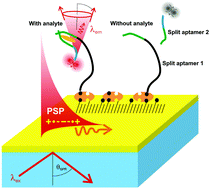A surface plasmon field-enhanced fluorescence reversible split aptamer biosensor†
Abstract
Surface plasmon field-enhanced fluorescence is reported for the readout of a heterogeneous assay that utilizes low affinity split aptamer ligands. Weak affinity ligands that reversibly interact with target analytes hold potential for facile implementation in continuous monitoring biosensor systems. This functionality is not possible without the regeneration of more commonly used assays relying on high affinity ligands and end-point measurement. In fluorescence-based sensors, the use of low affinity ligands allows avoiding this step but it imposes a challenge associated with the weak optical response to the specific capture of the target analyte which is also often masked by a strong background. The coupling of fluorophore labels with a confined field of surface plasmons is reported for strong amplification of the fluorescence signal emitted from the sensor surface and its efficient discrimination from the background. This optical scheme is demonstrated for time-resolved analysis of chosen model analytes – adenoside and adenosine triphosphate – with a split aptamer that exhibits an equilibrium affinity binding constant between 0.73 and 1.35 mM. The developed biosensor enables rapid and specific discrimination of target analyte concentration changes from low μM to mM in buffer as well as in 10% serum.

- This article is part of the themed collection: Bioanalytical Sensors


 Please wait while we load your content...
Please wait while we load your content...